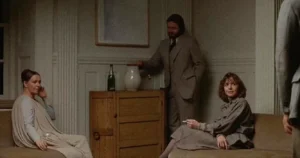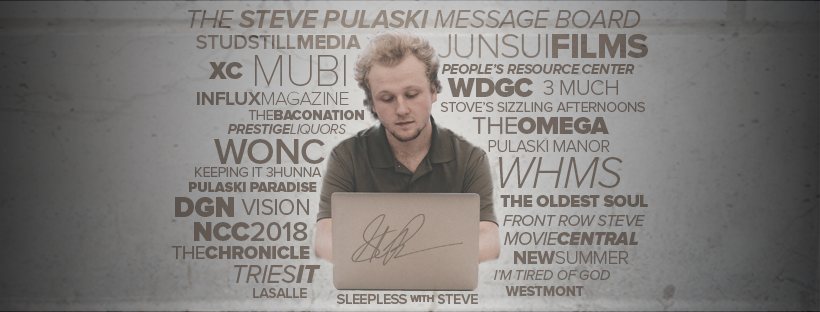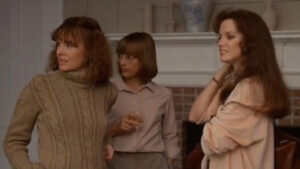Publication Date: 10-11-2025
Interiors (1978) review
Dir. Woody Allen
By: Steve Pulaski
Rating: ★★★½
 Remembering Diane Keaton
Remembering Diane Keaton
 1946 – 2025
1946 – 2025
Woody Allen’s first fully dramatic venture, Interiors, revolves around the troubled members of a medium-sized family, led by Arthur (E. G. Marshall), an attorney with three daughters, and Eve (Geraldine Page, who maybe gives the best performance), an interior decorator. Their children are Renata (Diane Keaton), a successful poet whose husband, Frederick (Richard Jordan), a lowly novelist, is greatly intimidated by her success, Flyn (Kristin Griffith), an actress belittled because of her performances in second-rate pictures, and Joey (Mary Beth Hurt), a sensitive journey-woman in her own career-path, who harbors contempt for her mother for devoting all of her attention to Renata and her successes.
This unstable world is rendered made even moreso when Arthur informs his daughters that he is separating from his wife. The film revolves around them coming to terms with their mother’s depression and later attempted suicide, while trying to adjust to some semblance of normalcy when Arthur returns from a business trip in Greece with Pearl (Maureen Stapleton). Pearl is everything Eve is not, but someone we might assume Eve could become if she wasn’t burdened by her own psychological torment.
Allen opens and closes Interiors quietly, with none of his hallmark jazz melodies to ease us into the story at hand. Quite the opposite. He paints his characters at the edge of a cliff and slowly watches them gravitate further and further towards the point of no return. In doing so, he and his crew evoke a melancholic chilliness to the film and its subjects that negates the tiniest presence of comedy; something, at this point, he hadn’t done in his career. Coming off a terrific upset win at the Oscars for Annie Hall, and before that, at least riding high on the personal satisfaction brought on by films like the Russian satire Love and Death and the futuristic Sleeper, Allen earned every bit of his reputation as a comedic filmmaker. His love for embracing the playful side of comedy, without relying on the overtly physical, and toying with the underlying romantic and dramatic aspects of his stories, comes to what, at one point, could’ve been called an unexpected halt.

However, in the present context, especially several decades and 30 films later by the prolific writer/director, Interiors seems much more like a natural evolution of Allen’s career. It’s a complex drama, with many of the characters’ feelings remaining internalized. What we get on the surface are the glimpses inside their sometimes icy exteriors or brutally, sometimes hurtfully, honest demeanors that do their part to build ostensibly impenetrable walls around their fragile emotional interiors. Consider Eve, who, right down to her surroundings, seems to flood the spaces she occupies with distance and space. The rooms in which she spends her time are often gray or colorless, reflecting her detached state. The shot of her lying down on her leather couch after taping the cracks of her large windows shut and turning on all the burners of the stove is one of Allen and cinematographer Gordon Willis’s most compelling. It shows Eve as a tiny part of a much larger, meticulously decorated room, with décor that practically swallows her to the point where, when she lies motionless, if only for a few seconds, she’s practically a statue. A frozen, anti-Aphrodite, broken, isolated, and practically minutes away from her own self-inflicted fate.
While no one would describe Joey as significantly happier, or even better off than her mother, we can see she’s at least livelier, with more of a willingness to express her emotions, even if that involves blurting her feelings in a caustic way. The backgrounds in which we see her are brighter, still only a muted beige or light-gold, but given the significance of interiors and spatial relations throughout this film, it’s not irrelevant that the space Joey occupies is more colorful and feels larger. Meanwhile, Renata is the most talkative of the bunch, to her troubled mother, her indecisive sister, and her husband, whose drinking progressively gets worse, leading to undeserved guilt on her behalf. By the end of Interiors, I felt as if I didn’t get to spend enough time getting to know Flyn, or at least understood her in the same way I had a loose grasp on her sisters. But scenes that show the toll her family’s harsh comments have taken on her as well as one between her and Frederick are enough to confirm she’s not better off, and quite possibly the most scarred of the three.
What Allen manages to do with space and restraint in Interiors is impressive, all in a way that doesn’t undercut the characters at its core. His approach to a large, interpersonal family conflict, unambiguously favoring the dramatic angle, is one filled with rich conversations and understated moments of emotion that emerge over the course of 90 minutes. The detached performances from its great cast also do their part and add up to an environment where characters internalize what they’re really trying to say and externalize raw, impulsive remarks that are just a few beats away from ruining an entire relationship. A Bergman-esque yet still distinctively Allen film, Interiors is a visceral achievement for the writer/director, at the time and in the present, now with added context.
Starring: Geraldine Page, Mary Beth Hurt, Diane Keaton, Kristin Griffith, E. G. Marshall, Maureen Stapleton, Richard Jordan, and Sam Waterston. Directed by: Woody Allen.
About Steve Pulaski
Steve Pulaski has been reviewing movies since 2009 for a barrage of different outlets. He graduated North Central College in 2018 and currently works as an on-air radio personality. He also hosts a weekly movie podcast called "Sleepless with Steve," dedicated to film and the film industry, on his YouTube channel. In addition to writing, he's a die-hard Chicago Bears fan and has two cats, appropriately named Siskel and Ebert!


